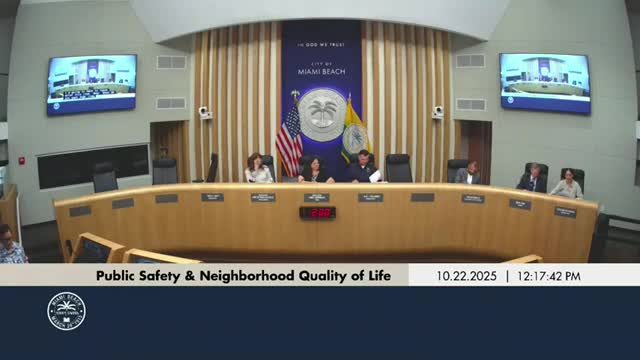Committee backs sending waterfront quiet‑zone signage to commission, staff to pursue waterway markers and landward pilot
October 23, 2025 | Miami Beach, Miami-Dade County, Florida
This article was created by AI summarizing key points discussed. AI makes mistakes, so for full details and context, please refer to the video of the full meeting. Please report any errors so we can fix them. Report an error »

Commissioners and staff told the committee that boat noise and speeding in residential waterways are recurring public complaints and that signs posted on land will be the faster, lower‑cost near‑term step while state and federal approvals are pursued for in‑water markers.
Lindsey Precht, deputy resilience officer and assistant director of the Environment & Sustainability Department, said marine patrol and code recommended mounting signage where it is visible from typical vessel distances from seawalls. "Vessels typically maintain a 50 to 100 foot buffer from seawalls," Precht said, and signage must be sized and sited accordingly. She said landward placement (the dry side of seawalls) minimizes additional permitting. By contrast, placing markers in the water would trigger approvals from agencies such as Miami‑Dade County, the Florida Fish and Wildlife Conservation Commission, the U.S. Coast Guard and possibly the U.S. Army Corps of Engineers.
Committee members expressed a desire to pursue both tracks. One commissioner moved to send the matter to the full commission with a positive recommendation for landward signs and to begin regulatory outreach for in‑water markers; the motion was seconded and carried in committee. Staff described potential pilot locations included in the memo: Monument Island, Marie Selby Park (noted as example sites), Venetian islands and other city easements and said in‑water marker permitting can be costly and time‑consuming. Cost estimates discussed by commissioners referenced six‑figure totals for substantial in‑water marker projects, and members asked staff to begin regulatory coordination immediately.
The committee directed staff to develop a pilot plan for landward signage on city‑owned seawalls, prepare cost estimates, and initiate conversations with state and federal agencies about waterway markers and navigational safety concerns. Staff suggested in‑house fabrication (parking department) could reduce sign costs for the landward pilot; full waterway markers will require additional permitting and may be resisted by some state agencies, Precht warned.
Lindsey Precht, deputy resilience officer and assistant director of the Environment & Sustainability Department, said marine patrol and code recommended mounting signage where it is visible from typical vessel distances from seawalls. "Vessels typically maintain a 50 to 100 foot buffer from seawalls," Precht said, and signage must be sized and sited accordingly. She said landward placement (the dry side of seawalls) minimizes additional permitting. By contrast, placing markers in the water would trigger approvals from agencies such as Miami‑Dade County, the Florida Fish and Wildlife Conservation Commission, the U.S. Coast Guard and possibly the U.S. Army Corps of Engineers.
Committee members expressed a desire to pursue both tracks. One commissioner moved to send the matter to the full commission with a positive recommendation for landward signs and to begin regulatory outreach for in‑water markers; the motion was seconded and carried in committee. Staff described potential pilot locations included in the memo: Monument Island, Marie Selby Park (noted as example sites), Venetian islands and other city easements and said in‑water marker permitting can be costly and time‑consuming. Cost estimates discussed by commissioners referenced six‑figure totals for substantial in‑water marker projects, and members asked staff to begin regulatory coordination immediately.
The committee directed staff to develop a pilot plan for landward signage on city‑owned seawalls, prepare cost estimates, and initiate conversations with state and federal agencies about waterway markers and navigational safety concerns. Staff suggested in‑house fabrication (parking department) could reduce sign costs for the landward pilot; full waterway markers will require additional permitting and may be resisted by some state agencies, Precht warned.
View full meeting
This article is based on a recent meeting—watch the full video and explore the complete transcript for deeper insights into the discussion.
View full meeting